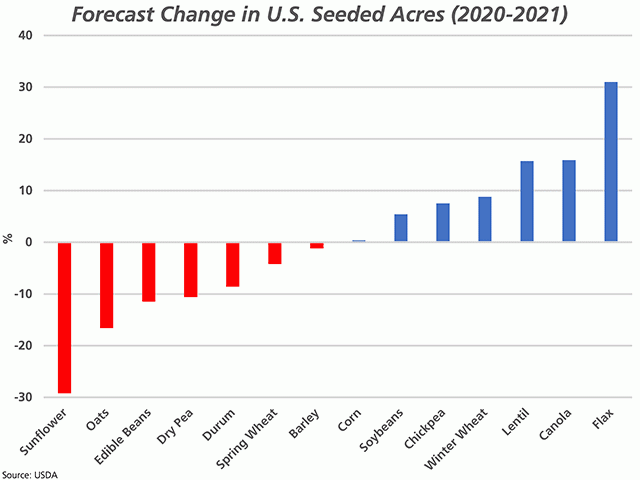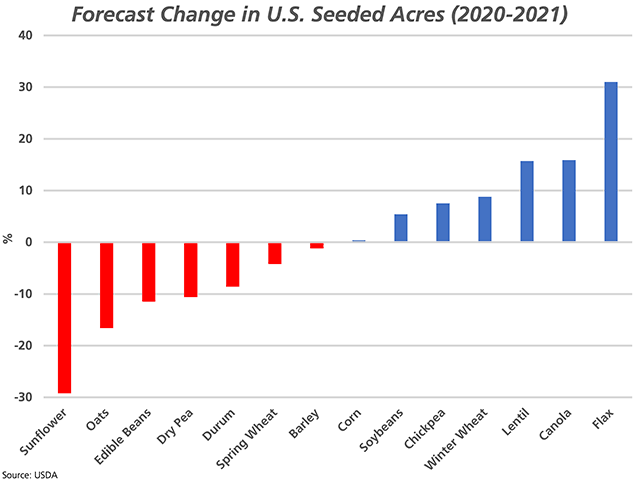Canada Markets
Year-Over-Year Change in US Seeded Acres
The March 31 Prospective Planting report released by the USDA will be talked about for some time, with the reported wheat acres above the level of pre-report estimates, while the forecast for both corn acres and soybean acres were not only below expectations, but below the lowest estimates found in a range of pre-report estimates reported by Dow Jones.
While the actual seeded acres will be refined in forecasts in the months to come, the limit-up move seen in both old-crop and new-crop corn and soybean futures while we face expanded limits for Thursday's April 1 trade have been a welcome change from the recent trend of noncommercial liquidation.
The attached chart shows the year-over-year percentage change in seeded acres for a number of selected U.S. crops, with red bars highlighting those crops where acres are forecast to fall from 2020 to 2021, while the blue bars represent those crops where seeded acres are expected to rise.
P[L1] D[0x0] M[300x250] OOP[F] ADUNIT[] T[]
One thing that will be watched with some skepticism is the overall increase in seeded acres found in the report. According to Dow Jones pre-report survey, the average of the estimates pointed to an expected 2.285 million acre increase in corn acres and a 6.905 ma increase in soybean acres, or a total of 9.190 million acres just for the two crops. Today's report shows a 4.841 ma increase for these two crops, just 325,000 acres for corn and 4.516 ma for soybeans. For all of the crops shown on the attached chart, the increase in planted acres totals 6 million.
Acres planted to oats, forecast at 2.488 million or down 16.6%, would result in the lowest area planted in 10 years. This compares to a more modest 3.5% drop currently forecast in AAFC's unofficial estimate for Canada, with survey-based estimates due for release on April 27. This could have implications for Canada's oat export potential and bears watching.
One could say the same for U.S. durum, forecast to fall by 144,000 acres or 8.6% to 1.540 ma, which is down from last year and compares to the 1.963 ma five-year average. This comes at a time when U.S. total durum use (exports plus domestic use) is currently forecast up 14.8% for 2020-21 while ending stocks are forecast to fall by 23.8%. Current unofficial Canadian estimates are calling for a 5.6% increase in acres.
Today's USDA report shows a forecast 15.7% or 290,000 acre increase in canola acres planted in the U.S in 2021 to 2.115 million acres, which would be the third time more than 2 million acres has been seeded and a record for the country. The largest jump is seen in North Dakota with intentions to plant 18% more acres to 1.780 million acres, or 84% of the country's total acres.
U.S. producers are expected to respond in a similar fashion to prairie producers when it comes to flax. The largest percentage gain in the crops shown is a 31% or 95,000 acre increase in flax acres to 400,000 acres. This increase is seen entirely in Montana and North Dakota, the only two states reported, while the 400,000 acres would be the largest area seeded in six years and 27.9% higher than the five-year average. Current unofficial estimates show Canadian producers increasing the area seeded by 22% in 2021 to 1.137 ma.
The USDA's forecast for a 4.2% drop in acres planted to spring wheat is close to the 5% percentage drop currently seen in the AAFC's unofficial forecast for 2021-22 for wheat (excluding durum), which includes Statistics Canada's forecast for a small increase in winter wheat acres planted last fall. The 10.9 million acres of hard red spring wheat acres in the U.S. is seen as the lowest area seeded in four years and is down 5.4% from the five-year average.
Cliff Jamieson can be reached at cliff.jamieson@dtn.com
Follow him on Twitter @Cliff Jamieson
(c) Copyright 2021 DTN, LLC. All rights reserved.





Comments
To comment, please Log In or Join our Community .